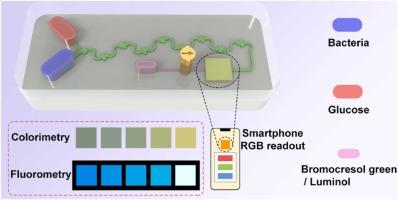葡萄糖代谢启发的扑克牌图案微流控芯片用于细菌检测和鉴定
IF 3.7
1区 化学
Q1 CHEMISTRY, ANALYTICAL
引用次数: 0
摘要
本研究提出了一种创新的扑克模式微流控芯片,特别是芯片上的俱乐部微混合器结构,旨在利用微流体和机器学习进行细菌检测和识别。这种微流控芯片结构从扑克牌图案中汲取灵感,利用混沌流和迪安涡流实现有效混合。本研究利用细菌代谢,结合比色法和荧光技术,在芯片上构建了一种双模式检测策略,利用细菌与葡萄糖之间的代谢相互作用。检出限(LOD)分别为8.8和7.6 CFU·mL-1。该微混合器对大肠杆菌检测具有较高的灵敏度,提高了混合效率,保持了良好的压降特性。机器学习聚类分析方法的集成进一步增强了系统区分不同细菌种类的能力。该微流控芯片在牛奶等实际样品中展示了其实用性,突出了其在食品安全和公共卫生监测领域的应用前景。本文章由计算机程序翻译,如有差异,请以英文原文为准。

Glucose metabolism-inspired poker-pattern microfluidic chip for bacterial detection and identification
This research presents an innovative poker-pattern microfluidic chip, specifically the club micromixer structure on a chip, designed to utilize microfluidics and machine learning for bacteria detection and discrimination. This microfluidic chip structure draws inspiration from playing card patterns and employs chaotic flow and Dean vortices to achieve effective mixing. This study utilizes bacterial metabolism to fabricate a dual-mode detection strategy on chip, combining colorimetric method with fluorescence techniques, both of which exploit metabolic interactions between bacteria and glucose. The limits of detection (LOD) are 8.8 and 7.6 CFU·mL−1 respectively. The micromixer exhibits higher sensitivity in Escherichia coli (E. coli) detection, as well as improving mixing efficiency and maintaining favorable pressure drop characteristics. The integration of machine learning cluster analysis methods further augments the system's capacity to discriminate among various bacterial species. The microfluidic chip demonstrates its practicality in real samples, such as milk, highlighting its prospective utility in the realms of food safety and public health surveillance.
求助全文
通过发布文献求助,成功后即可免费获取论文全文。
去求助
来源期刊

Sensors and Actuators B: Chemical
工程技术-电化学
CiteScore
14.60
自引率
11.90%
发文量
1776
审稿时长
3.2 months
期刊介绍:
Sensors & Actuators, B: Chemical is an international journal focused on the research and development of chemical transducers. It covers chemical sensors and biosensors, chemical actuators, and analytical microsystems. The journal is interdisciplinary, aiming to publish original works showcasing substantial advancements beyond the current state of the art in these fields, with practical applicability to solving meaningful analytical problems. Review articles are accepted by invitation from an Editor of the journal.
 求助内容:
求助内容: 应助结果提醒方式:
应助结果提醒方式:


